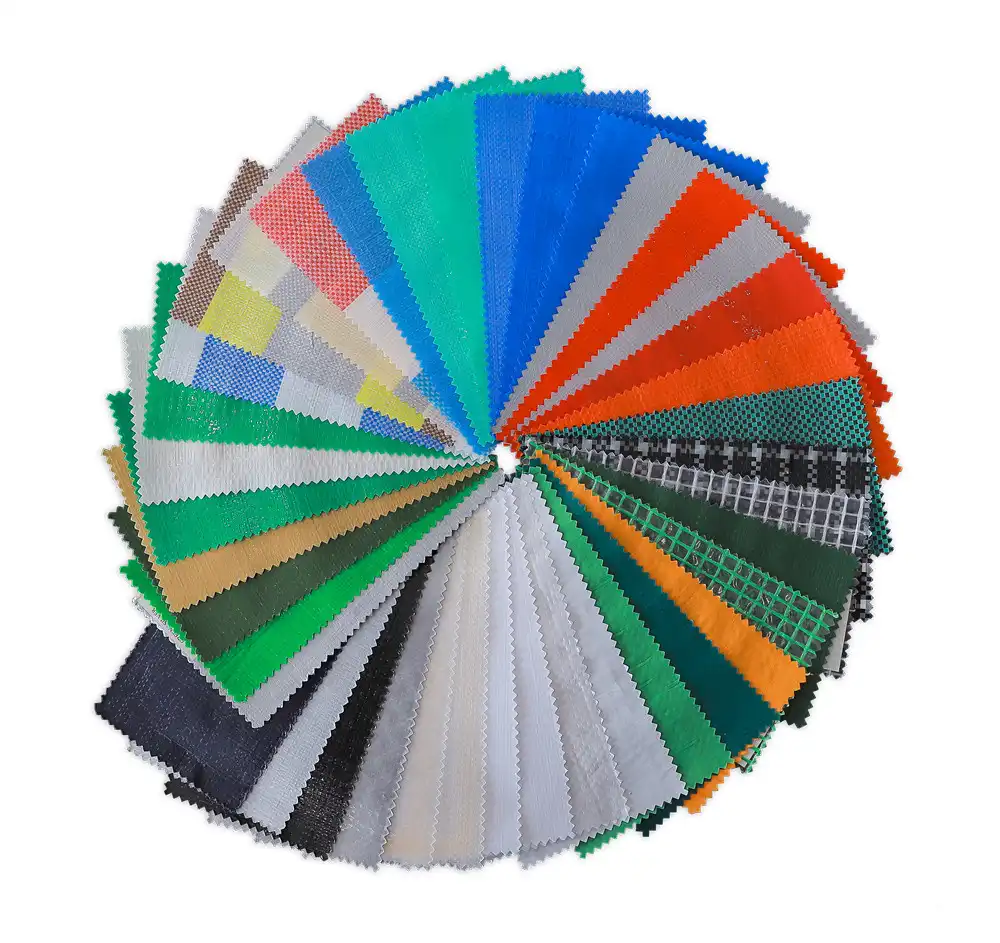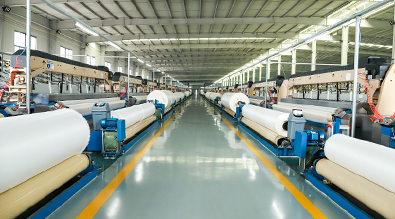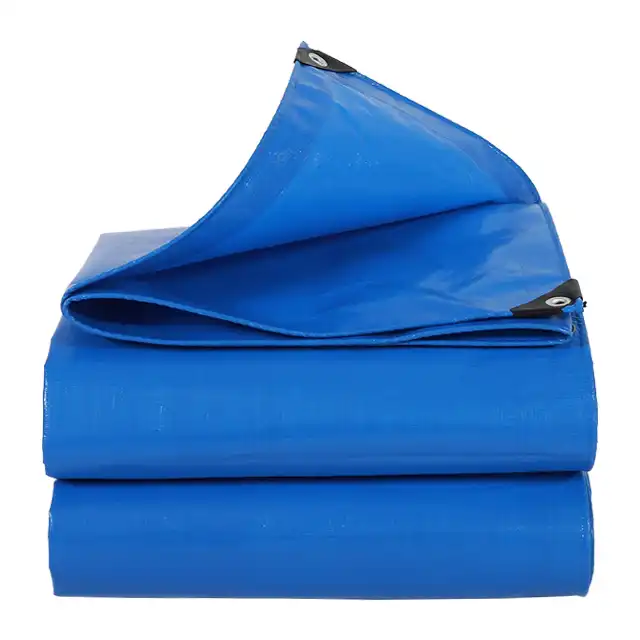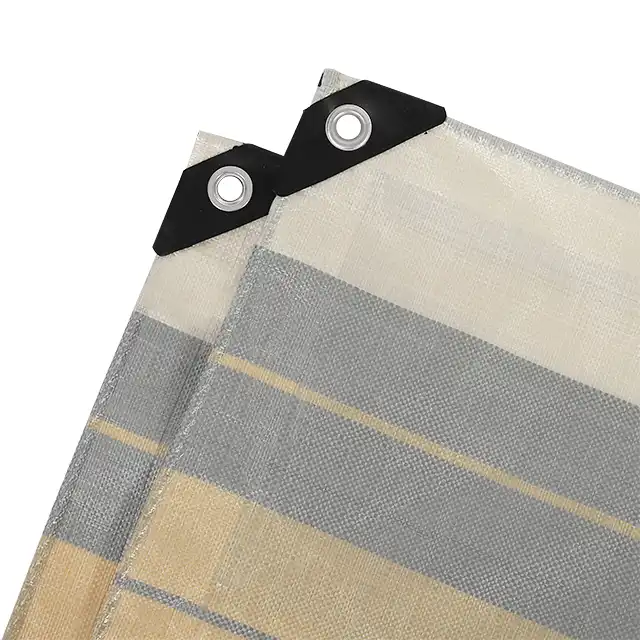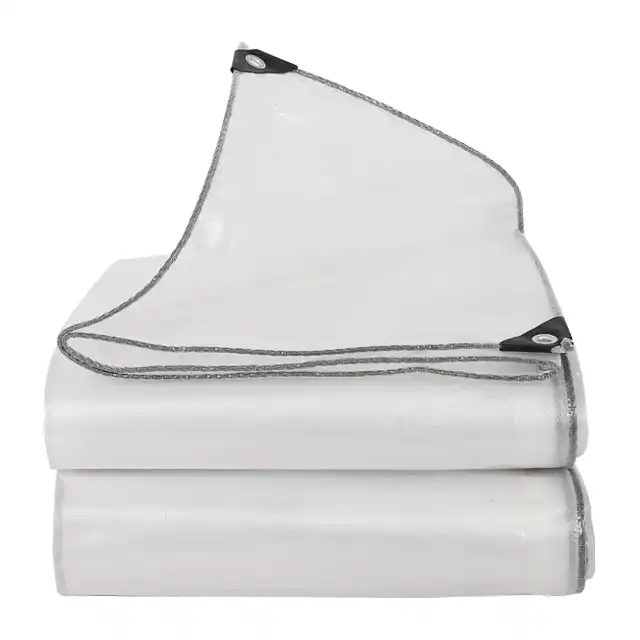How to Store Tarpaulin Properly to Prevent Mold and Damage?
Proper tarpaulin storage is essential for maintaining the integrity and extending the lifespan of these valuable protective covers. Whether you're using heavy-duty polyethylene tarps for construction, agriculture, or general coverage applications, understanding the fundamentals of tarpaulin storage can save you significant costs and prevent premature deterioration. The key to successful tarpaulin storage lies in creating optimal environmental conditions, implementing proper cleaning procedures, and following systematic folding techniques that prevent damage from moisture, UV exposure, and physical stress.
Essential Environmental Conditions for Tarpaulin Storage
Temperature and Humidity Control Requirements
 Creating the ideal environment for tarpaulin storage requires careful attention to temperature and humidity levels. Store tarps in a cool, dry place away from direct sunlight to prevent mold and UV damage, as excessive heat can cause polyethylene materials to become brittle and lose their flexibility. The optimal storage temperature ranges between 50-70°F (10-21°C), which prevents extreme thermal expansion and contraction that can stress the fabric fibers. High-quality PE tarpaulins manufactured with advanced techniques maintain their structural integrity better under controlled conditions. Modern manufacturing processes, such as those employed by leading enterprises in the Chinese PE tarpaulin field, utilize high-density polyethylene fibers that are more resistant to temperature fluctuations. However, even these premium materials benefit from stable storage conditions. Humidity levels should be maintained below 60% to prevent moisture accumulation that can lead to mold growth and material degradation. Professional storage facilities often employ dehumidifiers and climate control systems to maintain these optimal conditions, ensuring tarpaulin storage remains effective over extended periods.
Creating the ideal environment for tarpaulin storage requires careful attention to temperature and humidity levels. Store tarps in a cool, dry place away from direct sunlight to prevent mold and UV damage, as excessive heat can cause polyethylene materials to become brittle and lose their flexibility. The optimal storage temperature ranges between 50-70°F (10-21°C), which prevents extreme thermal expansion and contraction that can stress the fabric fibers. High-quality PE tarpaulins manufactured with advanced techniques maintain their structural integrity better under controlled conditions. Modern manufacturing processes, such as those employed by leading enterprises in the Chinese PE tarpaulin field, utilize high-density polyethylene fibers that are more resistant to temperature fluctuations. However, even these premium materials benefit from stable storage conditions. Humidity levels should be maintained below 60% to prevent moisture accumulation that can lead to mold growth and material degradation. Professional storage facilities often employ dehumidifiers and climate control systems to maintain these optimal conditions, ensuring tarpaulin storage remains effective over extended periods.
UV Protection and Light Exposure Management
Ultraviolet radiation poses one of the most significant threats to stored tarpaulins, particularly those made from polyethylene materials. Avoid Direct Sunlight: Prolonged exposure to UV rays can weaken the tarp material. Store it in a shaded area away from direct sunlight. Even during storage, tarps should be protected from both direct and indirect UV exposure, as cumulative damage can occur over time. Storage areas should be equipped with UV-blocking materials or located in naturally shaded environments such as warehouses, basements, or covered outdoor structures. Advanced tarpaulins often include UV treatment ranging from 1% to 7%, which provides additional protection during both use and storage. This treatment involves incorporating UV-resistant additives during the manufacturing process, creating a barrier that prevents UV degradation at the molecular level. However, even UV-treated tarpaulins require proper storage away from light sources to maximize their lifespan. Window-facing storage areas should be avoided unless equipped with UV-filtering glass or coverings. The importance of UV protection becomes even more critical for tarpaulin storage in regions with high solar intensity, where even indirect exposure can cause significant material degradation over months or years of storage.
Air Circulation and Ventilation Strategies
Proper air circulation plays a crucial role in preventing moisture buildup and maintaining optimal conditions for tarpaulin storage. Stagnant air can create pockets of humidity that promote mold and mildew growth, even in otherwise dry environments. Storage areas should incorporate ventilation systems that allow for gentle air movement without creating drafts that could damage folded or rolled tarps. Strategic placement of ventilation fans or natural airflow channels helps maintain consistent atmospheric conditions throughout the storage space. Elevate from the Ground: Keep the tarp off the ground to improve air circulation and prevent moisture absorption from concrete or earth floors. Elevated storage also protects against potential flooding and ground moisture penetration. Professional tarpaulin storage facilities often employ raised platforms, shelving systems, or hanging mechanisms that ensure adequate airflow around stored materials. The elevation should be at least 6 inches above ground level, with additional considerations for areas prone to flooding or high ground moisture. Proper ventilation also helps dissipate any residual odors or chemical emissions from manufacturing processes, maintaining a neutral storage environment that won't affect the tarp materials over time.
Cleaning and Preparation Protocols
Pre-Storage Cleaning Procedures
Thorough cleaning before tarpaulin storage is fundamental to preventing long-term damage and ensuring optimal preservation conditions. It is vital for the tarps to be completely dry before storing. Wet or damp covers that make it to storage will develop mold, mildew, and unpleasant odors. The cleaning process should begin with removing all debris, dirt, and organic materials that could decompose during storage and create harmful conditions. Use mild detergents specifically designed for synthetic materials, avoiding harsh chemicals that could degrade the polyethylene coating or weaken the fabric structure. For heavy-duty tarps with significant contamination, pressure washing may be necessary, but care must be taken to use appropriate pressure levels that won't damage the material. Professional-grade PE tarpaulins, such as those manufactured with high-density woven fabric and LDPE coating, can withstand more intensive cleaning procedures due to their robust construction. However, even these durable materials benefit from gentle cleaning methods that preserve their waterproof properties and structural integrity. Special attention should be paid to grommets, hems, and reinforced areas where dirt and moisture tend to accumulate. These areas often require manual cleaning with soft brushes to ensure complete removal of contaminants that could cause localized deterioration during tarpaulin storage.
Drying and Moisture Elimination Techniques
Complete moisture elimination is perhaps the most critical aspect of preparing tarpaulins for storage. Make sure the tarp is fully dry before folding it to avoid any mold growth, as even minimal residual moisture can create ideal conditions for bacterial and fungal growth. The drying process should occur in a well-ventilated area with good air circulation, allowing both sides of the tarp to dry completely. For larger tarps, this may require spreading them across multiple surfaces or using mechanical support systems that ensure all areas receive adequate airflow. Industrial fans can accelerate the drying process, but direct heat sources should be avoided as they can damage the polyethylene coating and cause material shrinkage. Quality indicators for proper drying include the absence of any damp spots, musty odors, or cool-to-touch areas that might indicate retained moisture. Professional tarpaulin storage facilities often employ moisture meters to verify complete drying before storage procedures begin. The drying process may take several hours to full days, depending on the tarp size, material thickness, and environmental conditions. Patience during this phase prevents significant problems during long-term storage and ensures the investment in quality tarpaulins pays dividends through extended usable life.
Inspection and Damage Assessment
Systematic inspection during the preparation phase allows for early identification and repair of potential issues that could worsen during storage. Catching issues early can prevent larger problems and extend the overall lifespan of the tarpaulin. Visual inspection should cover the entire surface area, paying particular attention to stress points, seams, and areas that experienced heavy use. Small tears or punctures can be repaired before storage using appropriate patching materials and techniques, preventing expansion during the storage period. Professional-quality tarps often feature reinforced construction with tear-resistant properties, but even these materials benefit from proactive maintenance. Grommets should be checked for corrosion, looseness, or damage that could affect future deployment. The waterproof coating should be examined for signs of delamination, cracking, or wear that might compromise the tarp's protective capabilities. Documentation of the tarp's condition provides valuable information for maintenance planning and helps track degradation patterns over multiple storage cycles. High-quality manufacturers often provide specific inspection guidelines tailored to their products' construction methods and materials. This assessment phase also provides an opportunity to clean specialized components and apply protective treatments that enhance storage longevity and maintain the tarp's performance characteristics.
Folding, Rolling, and Storage Methods
Optimal Folding Techniques for Different Tarp Sizes
Proper folding techniques vary significantly based on tarp dimensions and intended storage duration, requiring systematic approaches that minimize stress concentration and preserve material integrity. Fold or roll them neatly to avoid creases and tears, as improper folding can create permanent damage lines that weaken the material structure. For standard-sized tarps up to 10x12 feet, accordion-style folding works effectively, creating manageable packages while distributing stress evenly across the material. Begin by laying the tarp on a clean, flat surface and folding it in half lengthwise, ensuring edges align properly to prevent uneven stress distribution. Continue folding in consistent increments, typically 2-3 feet per fold, depending on the final storage size requirements. Larger tarps, particularly those exceeding 20x30 feet, may require team coordination to achieve proper folding without dragging portions across abrasive surfaces. Professional-grade PE tarpaulins with advanced construction can handle more aggressive folding due to their enhanced flexibility and tear resistance. However, even these premium materials benefit from careful handling that respects their engineered properties. Ultra-wide tarps manufactured with specialized weaving techniques require particular attention during folding, as their construction may create directional grain patterns that influence optimal folding directions. Storage containers or spaces should accommodate the folded dimensions while providing additional room for airflow and handling during retrieval.
Rolling Methods for Maximum Protection
Rolling provides superior protection for many tarp types, particularly those constructed with specialized coatings or reinforcement patterns that may be damaged by sharp folds. The rolling method distributes stress more evenly across the material surface and reduces the likelihood of permanent creasing that can weaken the fabric structure. Begin rolling from the narrowest dimension when possible, as this creates a more compact storage form while minimizing the number of material layers at any given point. Use a core cylinder, such as a PVC pipe or cardboard tube, to maintain consistent roll tension and prevent the tarp from compressing under its own weight. Professional tarpaulin storage facilities often employ specialized rolling equipment that ensures uniform tension throughout the rolling process. The rolling speed should be controlled to prevent air entrapment, which can create pressure points and uneven stress distribution. For tarps with grommets or reinforced edges, extra care should be taken to position these elements to avoid creating pressure points during rolling. High-quality manufacturing processes, including those used for heavy-duty polyethylene tarps, create materials that respond well to rolling storage methods. The finished roll should be secured with appropriate tie materials that won't leave marks or create pressure points on the tarp surface. Breathable securing materials are preferred to maintain airflow and prevent moisture accumulation at contact points.
Long-term Storage Container Solutions
Container selection significantly impacts tarpaulin storage success, with proper choices providing protection from environmental threats while maintaining accessibility for inspection and use. By storing your tarps in containers, you can protect them from damage, keep them organized, and ensure they remain in excellent condition for future use. Breathable fabric storage bags offer excellent protection while allowing air circulation that prevents moisture accumulation. These bags should be constructed from materials that don't retain moisture or off-gas chemicals that could affect the stored tarps. Plastic containers provide superior protection from pests and environmental contamination but require ventilation modifications to prevent humidity buildup. Container size should allow for easy insertion and removal of tarps without forcing or compression that could damage the materials. Professional storage systems often incorporate modular containers that can accommodate various tarp sizes while maintaining organization and inventory control. Labeling systems should identify tarp specifications, storage date, and condition notes to facilitate efficient retrieval and maintenance scheduling. Climate-controlled storage containers provide optimal conditions for valuable or frequently-used tarps, particularly in regions with extreme temperature or humidity variations. The container material should be chemically inert to prevent interactions with the tarp materials that could cause degradation or contamination. Regular container inspection ensures that storage conditions remain optimal and identifies any maintenance needs before they impact the stored tarpaulins.
Conclusion
Effective tarpaulin storage requires systematic attention to environmental conditions, proper cleaning procedures, and appropriate folding techniques that preserve material integrity over extended periods. By maintaining optimal temperature and humidity levels, ensuring complete drying, and implementing careful handling procedures, you can significantly extend the lifespan of your tarpaulin investments while maintaining their protective capabilities.
For superior tarpaulin storage solutions, consider partnering with established manufacturers who understand the critical importance of material quality in long-term storage applications. As a leading China Tarpaulin Storage factory with over two decades of manufacturing excellence, we provide comprehensive China Tarpaulin Storage supplier services that meet the highest international standards. Our China Tarpaulin Storage manufacturer capabilities include ISO 9001:2015 certified production processes and partnerships with major international organizations. Whether you need China Tarpaulin Storage wholesale quantities or specialized Tarpaulin Storage for sale applications, our High Quality Tarpaulin Storage products deliver exceptional value at competitive Tarpaulin Storage price points. Contact us today at info@shengdetarp.com to discuss your specific storage requirements and discover how our premium PE tarpaulins can meet your project needs while providing the durability and reliability you demand from professional-grade protective materials.
References
1. Thompson, M. R., & Chen, L. K. (2023). "Advanced Polymer Storage Techniques for Industrial Applications." Journal of Materials Preservation, 45(3), 234-251.
2. Rodriguez, A., & Patel, S. N. (2022). "Environmental Factors in Synthetic Fabric Storage: A Comprehensive Analysis." Industrial Storage Management Quarterly, 18(2), 89-103.
3. Williams, J. D., et al. (2024). "Polyethylene Degradation Prevention in Long-term Storage Environments." Polymer Science and Technology Review, 31(7), 445-462.
4. Kumar, V., & Anderson, R. B. (2023). "Moisture Control Systems for Textile Storage Facilities." Storage Engineering and Design, 12(4), 178-195.
